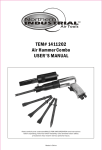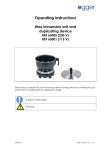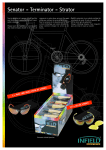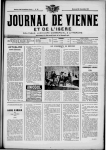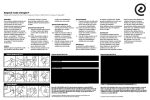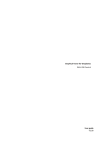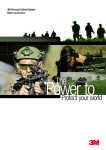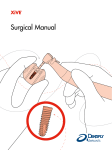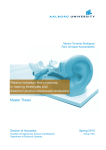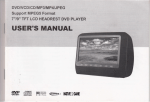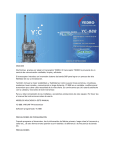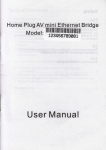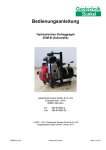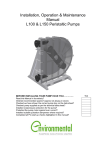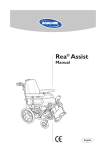Download or your senses perfection fo es r your senses - infield
Transcript
INFIELD Safety UK Ltd 1210 Parkview Arlington Business Park Theale Reading RG7 4TY T: F: E: W: 011896 57899 011896 57788 [email protected] www.infield-safety.de A Signet Armorlite Group Company PERFECTION FOR PE RY YOUR SENSESP PERFECTION FO OR YOUR SENSES ES Blindness separates us from things. Deafness separates us from people. © 13.11.110.2 / effective from 04.2014 Immanuel Kant Hearing Protection 2014 Contents Preface Topic Page Preface Products Products and special models The Human ear Hearing – How does it function? When do we perceive something as loud? Loss of hearing caused due to Noise, self-protection period Frequency analysis Laws and regulations Hearing protection according to INFIELD measure Moulding and Material Advantages of INFIELD Otoplastics Material, Maintenance, Service Contact 3 4-7 8 - 11 13 14 14 15 16 17 18 18 18 19 20 Hearing damage caused due to noise is irreversible When we sleep the entire body relaxes: the muscles, the eyes, the ears or at least, that is what we believe! However, our ears never sleep! How else can we explain how we can be awoken by noise? Be it a siren, the cry of a baby, our partner coughing or the alarm clock. All these sounds wake us. Most people are unaware of the health hazards caused by noise. Young people are particularly vulnerable to hearing damage as they tend to expose themselves to high volume levels at rock concerts, in the discos or while listening to their MP3 player with head phones. The established threshold for possible hearing damage is 85 decibels (dB), the pain threshold lies between 120 and 130 dB. That is the equivalent to the noise of a jet plane at a distance of 100 meters. In the home, decibel value prevails between 40 and 50 dB. In offices up to 65 dB. In traffic the decibel easily reaches 85 dB and Discos and Rock Concerts are around 110 dB and clearly louder than a jack hammer with 100 dB. In the work place there are specific regulations as to when the wearing of hearing protection is mandatory. Often the hearing protectors that are provided are not worn. Why? The reason most often given is the hearing protectors are often uncomfortable and communications unclear. The result is a feeling of isolation. Some users complain of headaches, while others complain about material allergies or unpleasant sweating caused by the hearing protection. Reasons for rejection of Hearing protectors Conventional Hearing protector Individually customized hearing protection designed by INFIELD Safety is comfortable and reduces noise levels, without acoustically isolating the user from his or her environment. INFIELD Otoplastics 2 3 Otoplastic with Phonor® Select Filter Phonor® Select Phonor® Select Digital Phonor® Select Alpha, 1, 2 and 3 offer good protection across the entire frequency spectrum. Phonor® Select Filter has S-V-W- and E Entry (see page 17). Because of our many years of experience in the field of hearing protection, the Phonor® Select Filters were developed exclusively for INFIELD and are utilised across a wide range of industries. All Phonor® products are made from soft Futuretec silicone 60 shore. They are also available in acrylic material (UV light curing material). Phonor® Select Digital, 1, 2 and 3 offer good protection across the entire frequency spectrum. Phonor® Select Digital Filter has S-V-W- and E Entry (see page 17). Because of our many years of experience in the field of hearing protection, the Phonor® Select Digital Filters were developed exclusively for INFIELD and are utilised across a wide range of industries. All Phonor products are made from acrylic material (UV light curing material). • • • • • • • • • • • • • • • • • • • • Choice of 4 filters types. High quality manufacture for a perfect fit. Less attenuation at 4000Hz, for better communication. Filters are interchangeable without special tools. Easy cleaning of the earplugs by purging. All earplugs have a unique, laser etched serial number. No special cleaning agents required. Recommended period of usage: 5 years. Made in Germany. Available only from INFIELD Safety. 4 Choice of 4 filters types. Manufactured with rapid prototyping process Otoplastics can be reproduced at any time Filters are interchangeable without special tools. Easy cleaning of the earplugs by purging. Unique Laser etched serial number. Dust resistant. Recommended period of usage: 4 years. Made in Germany. Available only from INFIELD Safety. 5 Otoplastic with Phonor® Select Filter Digital ER Work ER Work ER Music The new ER Work combines the practical advantages of Phonor® Select range and the linear insulation of the ER Music filter. It is particularly suited for forklift truck drivers, people who have a lot of phone calls or work with a walkie-talkies. Workstations where machines / engines are monitored and where discernment of machine / engine tone is important. The 3 filters within the group; ER 9, 15 and 25 have linear attenuation over the entire frequency range, offering excellent speech understanding and perception. The ER 15 filter meets the criteria for the S, V, W and E mark. (See page 17). The ER 9, 15 and 25 filters have been developed for musicians. They absorb sound across all frequencies without significant tone change. The filters satisfy the S-V-W and E descriptions (see page 17). ER is also ideal for pilots and persons who regularly attend concerts or clubs. • • • • • • • Choice of 3 filters. Filters have linear attenuation. True sound is perceived. Very good communication clarity Recommended period of usage: 5 years Made in Germany Unique, laser etched serial numbers. * RC 9: at 500 Hz and 4000 Hz, the APV84 is lower than the minimum required attenuation with regards to EN 352-2, i.e. the standard CE does not apply. 6 • • • • • • • • • Choice of 3 filters. Filters have linear attenuation. True sound is perceived. Very good communication clarity Perfect for Musicians Compatible with in-ear monitoring and mobile phone headsets. Recommended period of usage: 5 years Made in Germany Unique, laser etched serial numbers. ER Music * RC 9: at 500 Hz and 4000 Hz, the APV84 is lower than the minimum required attenuation with regards to EN 352-2, i.e. the standard CE does not apply. 7 SPECIAL PRODUCTS biem ER - Custom made head phones Shooter Is it possible to combine sound, protection and lifestyle in one product? Custom made Hearing protections for Shooters, Hunters and Industry. Yes. High quality materials and the latest electronic technologies allow INFIELD to create a custom made combination of protection and headphones specially designed for you. Suitable for making phone calls, listen to music and communication. BIEM ER is suitable for any ER hearing protection worldwide. Simply remove the filter from the earplugs – insert the headphones – enjoy your music, phone or other communications device that accepts a 3.5mm jack plug. Electronics: • Innovative filter electronics: reacting automatically to impulse and continual noise. • Electronic, active hearing protection. • Ideal for individual testing through modular structure • Easy use buttons • Battery size 10 (average battery life 70 hours) • Unique laser etched serial numbers. • Easy care by removing from the Otoplastic Warning: Electronic items should not be allowed to become wet. BIEM ER and original INFIELD ER Hearing Protection The ideal combination of custom made headphones and custom made hearing protection. Available in transparent, yellow, red or blue. Technical Details: • Impedance 18 ohm+/-10% • Echo: 110dB+/-3 • 20 Hz-20KHz • Aluminium case • Weather proof protection • Tested as per DIN 352-2 and 352-6 for communication cable • Kink proof cable with integrated microphone. • Switch for On / Off as well as receiving calls • Stereo cable – 3.5mm jack plug. Otoplastic: • Full modular • Sits securely and comfortably in the ear canal • Made from super soft (60 shore) material. • High density, easy to clean surface. The Otoplastic can be combined with BIEM ER headphones and ER 9, 15 and 25 passive hearing protection filters giving extra functionality. • Electrical active Hearing Protector (Shooter) • Passive hearing protector (ER 9, 15 or 25) • Communication and music (BIEM) Average value and Standard deviation of A-rated equivalent diffuse schield – Sound pressure level Sleepfit The Sleepfit is designed to fit particularly flat to the ear. Making it very comfortable whilst in the lying position, such as sleeping. It is designed as a sleeping aid for shift workers or those who have disturbed sleep due a partners snoring. It is also ideally suited for persons who wear full protective helmets, such as motorcyclists. The Sleepfit is coloured yellow as standard. Other colours are available on request. 8 9 Swim protection Delivery Experience the joy of care free bathing and swimming without the discomfort of water entering your ears. INFIELD’s scope of delivery always contains the following: • Stable storage box • Leather case for Otoplastic • Cord inclusive of a Shirt – Clip (apart from ER music) • Cleaning stick and Otofresh cream • User’s manual Cleaning spray and tissues can be ordered as accessories. Upon request a personal instruction can also be made available by our sales representatives. • • • • • • • Safety during bathing, swimming and shower For children and adults Individual custom made Buoyant, durable, tear proof, skin friendly and super soft silicon material easy to wear and remove through anatomically made grip easy to clean available in various respective colour combinations. Please note that the swim protector does not provide any protection during diving. Motor special • • • • • • Comfortable, custom fit protection. Clear discernment of warning signals and traffic noise Ideal for helmet wearers due to its extra small size. Fitted with the Phonor Select 1 filter, as standard. Other Phonor Select filters can also be used Tested according to DIN EN 352 – 2 Scope of INFIELD Delivery Leak test There are various possibilities by which Otoplastic can be tested for leakage. The results speak mainly about the fit of the Otoplastic and less about the actual leakage of the filter. While Leakage tests are mostly measured per ear (monaural) whereas the actual leakage is measured for both ears (binaural). 10 11 The ear - its anatomy Outer ear The outer ear is made up of the visible portion called the pinna and the ear canal. The human pinna’s functions are of no great importance, whilst animals can move and turn their ears to locate sounds. Middle ear The middle ear consists of eardrum, tympanic cavity and Eustachian tube. Inner ear The inner ear is made up of the organ of Corti and the cochlea. Ear canal The ear canal links the outer ear and the eardrum. It is approximately 3-4cm in depth and 0.5-1cm in diameter. It is completely covered with skin. The outermost part of the ear canal near the pinna is supported by cartilage, the inner part by bone. In the section made up of cartilage sebaceous glands secrete the yellow cerumen which is expelled by tiny hairs. Ear drum Between the ear canal and the tympanic cavity lies the eardrum. This membrane is approximately 1cm in diameter and 0.1mm thick. On the inside of the eardrum is a mucous membrane. It appears grey and shiny from the outside. Tympanic cavity In the tympanic cavity there are the three ear bones or ossicles: Hammer, anvil and stirrup as well as the semicircular canals of the vestibular apparatus. Hammer, anvil and stirrup The hammer, anvil and stirrup are three tiny bones that are connected to each other. They directly couple and amplify sound energy from the eardrum to the inner ear. Oval window Sound waves travel via this membrane from the ossicles to the inner ear. The inner ear is located in the cochlea, well protected by the petrous portion of the temporal bone (‘pyramid’). Round window The round window is positioned adjacent to the oval window and is the end point of the scala tympani. Eustachian tube The Eustachian tube links the tympanic cavity with the pharynx. Its main function is pressure equalisation in the ear. Cochlea The cochlea has three ducts called scale: The scalavestibuli and the scala tympani, which both contain perilymph. Between these two is the scala media filled with endolymph which contains the organ of Corti. The word cochlea is the latin word for snail and comes from the shape of the organ. Organ of Corti Authentic Hearing Organ. The organ of Corti is the essential part of our hearing. It is located in the cochlea and contains 25,000 hair cells, each equipped with 100 hairs called stereocilia. These hairs are the sensory receptors of the auditory system and pass on information from sound waves via the auditory nerve to the brain. N 13 Profile of the Ear 1. Outer ear 2. Ear canal 3. Ear drum 4. Hammer 5. Anvil 6. Stirrup 7. Oval window 8. Archway 9. Auditory nerve 10. Cochlea 11. Eustachian tube 12. Round window 13. Tympanic cavity Diagram of the cochlea 1. Scala vestibule 2. Organ of Corti 3. Scala tympani 4. Auditory nerve 100 120 140 e Jet Eng in hamme r Riveting e r machin Propell e e machin Drilling op Hearing protection needs to be worn Metal w orking sh Strong Heav y vehic le Hearing protection has to be provided 85 ile 80 utomob 50 Passeng er car Sensory threshold Pain barrier Irritation caused by lesion area Heavy a 10 Normal convers ation Sensorineural hearing loss. Loud noises destroy the hair cells in the Organ of Corti and can cause partial or complete loss of hearing. Frequency of the audibility, almost undecipherable Disturbance music Continuous exposure to high noise levels causes hearing loss that is irreversible in 95% of cases. Very often our bodies show symptoms that are not obviously linked with noise, like insomnia, poor concentration and cardiovascular disease. If you suffer from any of these complaints, it is advisable that your surroundings are analysed for noise. In case that source of dangerous noise levels have been identified and cannot be eliminated, hearing protection must be worn. Find more conditions associated with high noise levels in the following paragraphs. Soft rad io To be precise, the human ear doesn’t process sounds, but sound waves that resonate the eardrum. The resonance is amplified by the Ossicles in the Tympanic Cavity and reaches the inner ear through the Oval Window, where the actual hearing process begins. A very important factor in the hearing process is the frequency of sound. The unit of frequency is Hertz (Hz). Hertz is a measure of the number of sound waves per second. The amplification of sound by the Ossicles depends on the frequency. The best amplification of sound is achieved in the range of the human voice, between 1000 and 2000 Hz. When a sound wave reaches the Oval Window via the previously mentioned pathway, it is passed on via the Perilymph, inside the Scala vestibule, to trigger the Basilar Membrane. Depending on the frequency, sensory hairs in different locations on the Organ of Corti are triggered. An analogy would be waves breaking at specific points on the beach, depending on their size. This way we can distinguish between high and low pitches. From the Stereocilia the sound wave travels towards and resonates the Reissner’s membrane. The membrane experiences a deflection by the incoming wave to the sensory filaments. This resonance then triggers receptor cells which send an electric impulse along the auditory nerve to the brain. Here the sound is recognised and defined. For example as a note or a word. The ear responds 7 times faster than the eye. If we could see as fast as we can hear, we would see every single frame in TV broadcasts instead of fluid movements. Whispe rs 5. Organ of Corti 6. Scala tympani 7. Round window Possible damages Murmu r soun of leaved s Cochlea 1. Stirrup 2. Oval window 3. Helicotrema 4. Scala vestibule Hearing - how does it work? Damages for the ear Tinnitus (lat.: Tinkle) Around 3 Million people suffer from Tinnitus. This constant noise in the ears is mostly described as a whistling sound, but can also take the form of a buzzing, whooshing or rattling. It cannot be measured but is proven to lead to psychological problems and even suicide. There are many attempts for therapy but no guarantees for a successful cure. Tinnitus is not only caused by noise but also by stress, middle ear infection, and decreased blood flow to the inner ear or some medications. Often these symptoms are ignored, because they aren’t very obvious at first and they have a very slow progression. Protect yourself, your employees and your relatives with INFIELD customised hearing protection. When do we perceive something as loud? Self protection period Every noise not only has a specific frequency but also a volume. Volume is measured in Decibel (dB) and the following graph shows us typical well known sounds with their respective Decibel level. Our pain threshold is around 120dB. Hence sound with a volume level above 120dB causes pain in our ears. Should we need to maintain a distance of approx.1m in order to have a normal conversation, the background noise level could be up to 80dB. In such environments, one should not stay long without wearing hearing protection. Another crucial factor is the duration for which one is exposed to noise. The human ear has a kind of "self-protection", comparable to the selfprotection of the skin against the sun's harmful rays. This allows us to be exposed to a noise level of 80 dB for about eight hours without being damaged. A small increase in the noise level to 83 dB, reduces this duration by half, to only four hours. The course of this phenomenon can be seen in the image opposite. So if one is regularly exposed for long periods of time in environments with noise levels in excess of 80dB, ear protection is essential to prevent permanent damage. Self protection acceptance on the left: Examples of various volumes in decibels 14 15 Frequency analysis Laws and Regulations For optimum protection, detailed knowledge of the users work environment is needed. Noise within manufacturing is not only generated by the machines in use but also many other background noises with different frequencies. Specialists have fixed 1000Hz as the standard frequency; this is the lower range of the human voice. INFIELD’s frequency analysis always refers to 1000Hz as well as six other frequencies. Three of these frequencies are higher in octave steps; three are at lower octave steps. The fixed frequencies are 125, 250, 500, 1000, 2000, 4000 and 8000Hz. Please note that a comprehensive frequency analysis is a sign of professionalism and quality of service. In the frequency based tables for noise reduction you find a lot of numbers. We would like to explain these to you. Now that you are familiar with how these frequencies have been chosen, we’ll explain more about the individual numbers. First of all, the term ’noise’ needs to be defined. Legislation describes it as ‘any type of sound that disturbs, bothers or damages the health of people, i.e. all sounds that compromise physical, mental and social well-being’. According to EU guidelines (2006) the following applies: - at 80dB or above – Hearing protection has to be provided. - at 85dB or above – Hearing protection must be worn. Within Europe, all hearing protection products must conform to the appropriate CE standard. Custom Made Hearing Protection comes under the category PPE (Personal Protective Equipment) and must comply with the following standards: • EN 352-2:2002: Hearing protection – Ear plugs • EN 352-6:2002: Hearing protection with electrical audio input The standards were completed in 2003 with new classifications: • EN 13819-1: Individual Hearing Protection: Physical test methods • EN 13819-2: Individual Hearing Protection: Acoustic test methods • The old 352-series is limited to the specific demands that are set by delivery conditions and guidelines Analysis of Individual Noise Situation Positive - List of Infield Otoplastics Type of marking Usage Limits [db(A)] HM L 95 96 104 103 95 96 104 103 106 103 104 100 99 93 106 104 112 108 105 101 102 98 110 107 Frequency analysis jargon The APV (Assumed Protection Value) is measured in Decibels (dB). The CE-mark is only issued for hearing protection if this value is above legislated level. Legislated APVs for the CE-Mark The Mf–value (in dB), determines the mean attenuation of a frequency. For example 25dB at 500Hz means a noise reduction of 25dB at the frequency of 500Hz. The Sf–value (in dB) is an assumed standard deviation that contributes towards the determination of the APV. The SNR–value is the mean attenuation for the complete analysed spectrum of frequencies, i.e. from 125- 8000Hz. The H/M/L–values are the mean attenuation in the respective areas of frequencies. H = High frequency (2000-8000 Hz) M = Medium frequency ( 500-2000 Hz) L = Low frequency (125-500 Hz) ER Music ER15 ER Music ER25 ER Work ER15 ER Work ER25 Phonor Select 1 Phonor Select 2 Phonor Select 3 Phonor Select alpha Phonor Select Digital 1 Phonor Select Digital 2 Phonor Select Digital 3 Phonor Select Digital alpha Notes SVWE SVWE SVWE SVWE SVW * W * * SVWE SVW W SVW Description: H M = High / Medium frequency noise (L C - L A < 5 dB), HML verified according to EN 458 L = Low frequency noise (L C - L A > 5 dB), HML verified according to EN 458 S = Audible signals in railway construction are discernible V = Audible signals for vehicle drivers in road traffic conditions are discernible W = Meets the criteria for ‘General warning signals’, ‘Informative noises’ and ‘Voice comprehension’ E = Audible signals for shunting and mainline railway locomotive drivers are discernible * = The hearing protectors were tested and/or certified by the IFA institute. The graphs illustrate the attenuation that is achieved by the individual filters. Customised hearing protection provides attenuation that is evenly balanced across the relevant spectrum of frequencies in contrast to standard hearing protection. Frequency table in original size: Pages 4-7 16 Operations Instructions [db(A)] HM L 80 - 90 81 - 91 89 - 99 88 - 98 80 - 90 81 - 91 89 - 99 88 - 98 91 - 101 88 - 98 89 - 99 85 - 95 84 - 94 78 - 88 91 - 101 89 - 99 97 - 107 93 - 103 90 - 100 86 - 96 87 - 97 83 - 93 95 - 105 92 - 102 17 Hearing protection according to INFIELD Material and Maintenance According to usage, INFIELD offer several variants of Otoplastics, available in a range of colours. • Phonor® Select • Phonor® Select Digital • ER Work • ER Music Material All ear protectors are made from a soft, flexible material. Their mechanical and chemical stability assures a long service life. The Phonor® Select can also be made digitally in UV polymerizate material. INFIELD hearing protection has the considerable advantage that it does not cause any feeling of pressure in the ear canal, even after hours of wearing. By default, all types are manufactured in transparent materials. The otoplastics can be specified in the signal colours Red, Blue or Yellow. Special versions: All models can be fitted with a tiny metal ball (detection ball). These specialised models are mainly of interest to the food and chemical industries. By default, a cord with shirt clip is delivered in Green. It is also available in high visibility Neon Orange or made of difficult flammable material (Yellow) or as a detectable metal woven cord (Black). The shirt clip is also detectable. Moulding and manufacture Moulding with the Injector Emptying out of the plastic mould Work on the slug Service and Guarantee The ear plug is custom moulded to each user. It consists of the silicone earplug and the acoustic filter itself. Before beginning the manufacturing process, an examination has to be carried out to assess that it is safe to inject the moulding putty into the ear canal. During this examination, excess Cerumen (earwax) or Cerumen plugs should be removed from the ear canal. The moulding is performed according to current best practice for the fitting of hearing aids.The moulding material is a pliable two-component putty based on silicone. This is injected into the ear canal without any noticeable pressure. The moulding process is normally not uncomfortable. The result is a perfect copy of the ear canal and part of the Pinna. In the next production step, this mould is then used to form the final earpiece. This ensures it fits comfortably into the ear canal. A ventilation hole is drilled into the part that inserts into the ear canal and the appropriate acoustic filter is fitted, specifically tuned to your requirements for noise reduction. Advantages of individual custom made Hearing protectors • • • • • • • • • • • Maintenance No special treatment products are required. Cleaning with water is sufficient. Service We offer comprehensive consultation and aftercare. Please contact us directly for general information and individual queries. Guarantee INFIELD hearing protection products are of high quality and can last many years with the appropriate care. We offer a 2 year warranty on fit and protection. Testing of Attenuation Values Infield safety provides with their hearing protectors guaranteed Insulation values. The individual products have cleared the Type Test according to EN 352-2:2-2002 in the PZT GmbH, Wilhelmshaven and is CE-certified ( 1974 ) Customised for perfect fit Optimum protection Communication is retained Filters are individually chosen to suit the working environment. Important sounds and signals can still be heard Ideal comfort, hardly noticeable High user acceptance Easy to wear with other items of PPE Easy to fit Easy to clean Many applications. For example: metal industry, car manufacture, printing industry, cement works, food industry, chemical industry, woodworking industry, bottling plants and motor sports. Drilling of the hole for the filter 18 19










